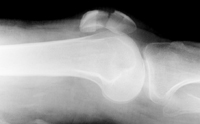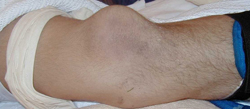Knee
History - nature of injury, e.g.. direct, indirect, rotational, presence of locking, giving way. Previous knee problems.
Examination - look, e.g.. wasting, deformity, swelling, bruising.
Feel - effusion, localise tenderness, check stability, popliteal swelling?
Move - check range, exclude locking by comparing extension on both sides - McMurray's test.
X-ray - For AP & Lat views see Ottawa Knee rules below. Additional views should include skyline view for patellar problems and tunnel view for intercondylar area (e.g. loose bodies)
Ottawa knee rule
A knee X-ray series is only required for knee injury patients with any of these findings:
- Age ≥ 55
- Isolated tenderness of the patella (no bone tenderness of the knee other than the patella)
- Tenderness at the head of the fibula
- Inability to flex to 90°
- Inability to bear weight both immediately and in the ED
(4 steps; unable to transfer weight twice onto each lower limb regardless of limping)
Aspiration
Evidence for aspiration to improve symptoms ? [BestBets]
Indications are: A) Tense haemarthrosis and B)Diagnostic uncertainty
Large effusion or haemarthrosis
- Aspirate under full aseptic conditions, unless immediate referral or surgery intended because of severity of injury
- If frank blood in the joint:
- Immobilise in POP knee backslab and refer to VFAC
- Refer to senior ED staff or on-call Orthopaedic Team
- There is no evidence to support early MRI in acute traumatic knee haemarthoses with normal x-rays [BestBets]
Locked knee
The knee will flex but will not fully extend. Refer to the on-call Orthopaedic Team.
Collateral ligament tear
Tenderness and pain on stressing the ligament. If there is definite laxity and marked bruising/swelling obtain an opinion from EM Duty Doc. Complete ligament rupture can be masked by muscle spasm. If little laxity or pain is evident, refer to the ED physiotherapist.
Possible meniscal tear
If not locked, apply a double tubigrip and provide crutches. Refer ED physio clinic.
Possible torn cruciate ligaments.
ACL clinical
Use the lever test:
- Patient supine, knee fully extended
- Provider's fist is placed at the level of the tibial tuberosity on the back side of the leg on the bed, thus causing the knee to bend slightly
- Downward pressure is applied to the distal femur, thus creating a lever from the patient's leg, with the fist as the fulcrum
- If the ACL is intact, the foot rises off the bed (the lever is working), but if the ACL is torn, the foot remains on the bed (the lever is broken)
Lachman & ant. drawer tests are difficult (pain/swelling) & have poor interrater reliability.
Loose bodies
If symptomatic refer to the orthopaedic clinic.
Anterior knee pain (chondromalacia patellae)
Please refer to the physiotherapy clinic and GP.
Soft tissue knee problems of uncertain cause - refer to ED physiotherapist.
Knee dislocations
Check distal circulation. Refer to the on-call Orthopaedic Team.
Distal femoral and upper tibial fractures
(including osteochondral)- refer to the on-call Orthopaedic Team.
Patellar fractures

- If undisplaced apply POP backslab and refer to CUH VFAC
- If displaced, refer to the on-call Orthopaedic Team
- Most need internal fixation as quads tone distracts the fragments
- Consider prophylactic anticoagulation (e.g. Rivaroxaban) if high risk of VTE/Hx DVT.[BestBets]
Dislocated patella

- Usually reduced before presentation - if not, reduce by extending hip (Entonox)
- X-ray to exclude fracture
- If 1st episode, treat conservatively in preference to surgery [BestBets]
- If 1st episode, apply cricket bat splint in preference to PoP cylinder [BestBets]
- Refer to the VFAC
- Consider prophylactic anticoagulation (e.g. Rivaroxaban) if high risk of VTE/Hx DVT.[BestBets]
Osteochondritis Dessicans
Please see anterior knee pain section.
Thromboprophylaxis
In patients immobilised in leg casts:
- Consider prophylactic anticoagulation (e.g. Rivaroxaban) if high risk of VTE or prior DVT [BestBets]
- As agreed with Orthopaedics in CUH, prophylactic anticoagulation is not required those patients discharged in a backslab
References
- Guiraud K, Silvestre G, Bastin C, et al. Higher sensitivity with the lever sign test for diagnosis of anterior cruciate ligament rupture in the emergency department. Arch Orthop Trauma Surg. 2022;142(8):1979-1983 DOI: 10.1007/s00402-021-04154-x
- Frobell RB et al. Treatment for acute anterior cruciate ligament tear: five year outcome of randomised trial. BMJ 2013;346:f232